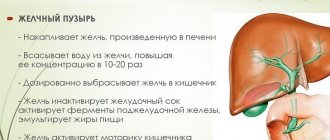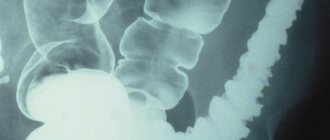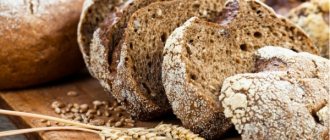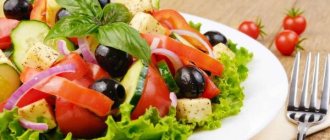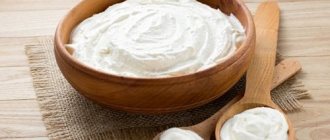Dairy products for gastritis
Gastritis has practically no cure. To clear the stomach of Helicobacter pylori, strong antibiotics are used, but even in this case, success is not guaranteed. Therefore, it is important to pay great attention to nutrition and follow a diet.
It is necessary to eat dairy during gastritis so as not to deprive the body of a valuable source of proteins and calcium, which are important for the musculoskeletal system.
It is not recommended to eat fermented milk products for gastritis with high acidity. Cottage cheese, kefir, cheese, fermented baked milk, sour milk, sour milk, sour cream, whey cannot be eaten. They contain lactic acid, which increases the already high level of acidity in your stomach. This causes the gastric mucosa to become even more inflamed.
Non-acidic dairy products can be eaten for gastritis with high acidity. Fresh homemade milk, cream, natural yogurt, light curd puddings and cheesecakes made from mashed cottage cheese, mild grated cheese, acidophilus, butter, pancakes for gastritis are allowed if they are not sour, not salty, without seasonings, stabilizers, preservatives and other artificial ingredients .
Any dairy products for gastritis with low acidity are prohibited only during exacerbations; during periods of remission, everything listed above can be consumed in reasonable quantities.
Is it possible or not?
Gastritis with high acidity is accompanied by symptoms such as pain in the epigastric region, vomiting, nausea, belching with a sour taste, and burning in the chest. As a rule, the doctor prescribes treatment that is aimed not only at eliminating the inflammatory process, but also at reducing the concentration of hydrochloric acid in the gastric juice. When determining the method of therapy, special attention is paid to the patient’s diet. The specialist should give recommendations regarding nutrition.
Fermented milk products for gastritis with high acidity can be consumed in limited quantities. However, this must be done with extreme caution. Each fermented milk product has its own contraindications and indications. Therefore, when preparing a diet for a patient with gastritis, the individual characteristics of the body and the stage of the disease are taken into account.
Gastritis and dairy products
Most patients are interested in the question - is it possible to eat dairy products for gastritis and will they cause harm? If the patient has increased stomach acidity, it is recommended to consume low-fat milk and fermented baked milk. But you should avoid sour cream. If your stomach acidity is low, you can add sour dairy products to your diet - kefir, cream, low-fat milk. Ryazhenka will also make an invaluable contribution to the functioning of the stomach.
Rules for consuming dairy products:
If you have low stomach acidity, you can add sour dairy products to your diet, kefir cream, low-fat milk
- It is necessary to completely exclude sour cream and sharp cheeses from the diet, as well as condensed milk in any form;
- Milk can only be drunk warm;
- if the acidity of the stomach is low, it is better not to consume milk in its “live” form, but add it to tea and porridge;
- gastritis can be cured with cereal porridges prepared in water with the addition of milk. Particular benefits are noted from oatmeal and buckwheat;
- You need to drink whole milk in small sips;
- you should not drink fermented milk products, including fermented baked milk, on an empty stomach;
- cow's milk can be replaced with goat's milk, which will significantly speed up the healing process;
- If you have gastritis, you should not drink dairy products that have expired. The best option is to buy fresh drinks made today;
- The healthiest dairy products are sold in villages. If possible, you should only consume fresh, unprocessed milk.
Thus, dairy products can be called friends of the stomach. They help restore natural microflora, saturate the intestines with beneficial bacteria and prevent further development of the disease. However, dairy products can be an addition to the main treatment, but not a replacement for it.
Benefits and harms
Dairy products are food products made from the milk of animals (cows, sheep, goats, etc.). First of all, these include drinking milk of varying fat content, as well as condensed milk, ice cream, various milk drinks with added sugar, vitamins and other ingredients.
Fermented milk products are food products produced from milk by ripening or fermentation . These include butter, cheese, cottage cheese, kefir, yogurt, fermented baked milk and many other products, including national ones (kumys, ayran, tan, matsoni, kaymak).
Dairy and fermented milk products are valuable food products that contain animal protein, calcium and other microelements, vitamins A, D, E, B1, B2.
Expert opinion
Irina Vasilievna
Practicing gastroenterologist
Milk, dairy and fermented milk products are useful for physical exhaustion, anemia, after illnesses , as well as in cases where “heavy” animal protein (meat, poultry, fish) should be replaced with a “lighter” one.
Not all people can drink natural milk due to lactose intolerance or milk protein allergy. A salvation for them can be fermented milk products, which are not inferior to milk in terms of nutritional value, but are absorbed by the body much better.
In addition, the beneficial bacteria they contain have a beneficial effect on digestion: they improve the digestibility of food, relieve constipation, and help strengthen local and general immunity.
On our website: Diet No. 1: a complete description and list of recommendations for patients with gastritis
Dairy products for gastritis with high acidity
Dairy products for gastritis with high acidity are allowed to be consumed, but very carefully and in limited quantities - this is especially true for fermented milk drinks. In principle, each dairy product has its own indications and contraindications, therefore, when deciding whether to include such products in a patient’s diet, it is necessary to take into account all the individual characteristics of the patient and his illness.
Cottage cheese for gastritis with high acidity
Cottage cheese is often recommended for gastritis and high acidity, since this product is easily accepted by the stomach and does not linger in it. For gastritis, it is important that the cottage cheese be low-fat, without adding salt and nuts, and always fresh.
Cottage cheese is allowed to be eaten during gastritis, but not during the initial 2-3 days of exacerbation. Also, you should not eat sour cottage cheese, too fatty, or with additives. The most optimal cottage cheese dish for gastritis with high acidity is a cottage cheese casserole, but without nuts and dried fruits. You can add honey to the casserole.
Cottage cheese is often recommended for gastritis and high acidity since this product is easily accepted by the stomach and does not linger in it
An ideal option for gastritis with high acidity is fresh homemade dietary cottage cheese with a soft consistency. It can be eaten pureed; it makes excellent puddings or soufflés, dumplings and casseroles.
Cheese for gastritis with high acidity
Ordinary hard cheese is allowed to be eaten for gastritis with high acidity, but not earlier than the seventh day after the onset of the acute period, and in relatively small quantities.
For gastritis, it is better to give preference to fresh unleavened cheeses, such as Ricotta, Mascarpone, Mozzarella. In addition, blue cheeses are not prohibited - however, in the store you should always make sure that such a product has not expired. Blue cheese has an astringent property and strengthens the natural protective layer of the stomach.
But we should not forget that the amount of cheese consumed for gastritis should not be too large: a few slices per day are enough.
Yogurt for gastritis with high acidity
For gastritis with high acidity, drinking yogurt is allowed, but taking into account the following rules:
- consumption of the product should be moderate - you should not drink a large amount at one time. It is better to eat often, but in several spoons;
- yogurt should not be fatty (optimally 2-2.5%);
- yogurt should be fresh and not sour.
Sour cream for gastritis with high acidity
Low-fat homemade sour cream can be added to dishes in an amount of no more than 15 g at a time and only during the period of remission of gastritis.
For gastritis with high acidity, it is not recommended to use industrially produced sour cream, even if the product is positioned as dietary. There are also restrictions on homemade natural sour cream: it should not be very fatty, since fats create additional stress on the liver and bile secretion system. Low-fat homemade sour cream can be added to dishes in an amount of no more than 15 g at a time, and only during the period of remission of gastritis.
Butter for gastritis with high acidity
For gastritis with high acidity, oil consumption should be limited, but you should not give it up completely. The normal amount of this product per day for a patient with gastritis is no more than 25 g. This is exactly how much oil is needed in order not to harm, but, on the contrary, to bring maximum benefit to the body.
Curdled milk kefir fermented baked milk for gastritis with high acidity
For gastritis with high acidity, this product should be used with caution, despite the many beneficial properties. It is necessary to limit the consumption of yogurt during periods of exacerbation of gastritis, as this drink can aggravate the situation in the stomach.
For gastritis with high acidity, you can drink kefir with 2-3% fat content, and only fresh (1-2 days). This kefir has an enveloping property and normalizes intestinal motility. The freshness of the drink is the main condition for its consumption by patients with gastritis. You need to consume kefir in moderation: little by little throughout the day. If you drink a lot of fermented milk drink at once, you can provoke diarrhea.
Many experts do not advise drinking this product during the first week after an exacerbation of gastritis with high acidity. After a week has passed since the beginning of the acute period, it is permissible to consume fermented baked milk, but in very small quantities - 100-150 ml per day.
Benefits of cottage cheese
It is often recommended to use cottage cheese for gastritis with high acidity. This product is quickly and easily absorbed. However, there are some limitations here too. For gastritis, you should eat low-fat fresh cottage cheese, without nuts, salt and various preservatives.
A homemade product is ideal. It is dietary, soft and tender. This cottage cheese can be consumed pureed. You can also use it to make soufflés or puddings, casseroles and dumplings.
This product should be used for gastritis three days after the onset of exacerbation. You should not use fatty, sour cottage cheese with all kinds of additives for cooking.
For gastritis, it is better to use this product in the form of a casserole. However, adding dried fruits and nuts to such a dish is not recommended. You can use a small amount of honey to add sweetness to the casserole.
Is it possible to eat milk if you have gastritis?
https://youtu.be/aqtnJ2uDshI
It is necessary to eat dairy during gastritis so as not to deprive the body of a valuable source of proteins and calcium, which are important for the musculoskeletal system and the muscular corset. However, it is important to take into account the form and stage of the disease, the presence of exacerbation, and general symptoms.
In a low acid environment, nutritionists advise eating any fermented milk dishes, but it is advisable to stick to options labeled “bio”. This indicates that the product is populated with natural microflora, which is useful for restoring the mucous membrane, digestion and peristalsis. For the hypoacid form of the disease, homemade non-acidic yogurt is most useful, which you can prepare yourself from milk, lactobacilli and special starter cultures.
Milk and cream for gastritis
It is important to remember the rule that these products are food, not drinks. Doctors do not recommend quenching your thirst with them, or drinking other foods, especially fatty and protein foods. On the contrary, they should serve as a complete snack between main meals.
Gastroenterologists advise patients to stick to goat or sheep milk, which have natural anti-inflammatory properties.
It is important for gastritics to drink drinks at room temperature, since too hot ones burn the irritated mucous membrane, and cold ones slow down the absorption of ingredients and digestion. Gastroenterologists advise patients to stick to goat or sheep milk, which have natural anti-inflammatory properties. The protein lysozyme in their composition is capable of healing small cracks in the gastric mucosa and starting regeneration processes.
Cottage cheese and curd mass for gastritis
You can eat these dairy products for gastritis with high acidity, but you just need to stick to options with a low fat percentage (up to 5). It is also necessary to consume them not in their pure form, but in the form of dumplings, cheesecakes, casseroles, soufflés, and puddings.
Glazed cheese, soft cheese, desserts, sour cream cheese for gastritis
The patient is allowed to eat mild, unsalted and moderately fatty hard cheeses, which will not irritate the delicate mucous membrane of the gastrointestinal tract. All of the listed dishes are undesirable for the patient to consume, as they contain flavor enhancers, acidity regulators, flavorings, and food additives. Also, most of these desserts are very fatty. It is not advisable for a patient to eat ice cream more than 1-2 times a year, since the product is a concentrate of trans fats, preservatives and sugar. And in general, cold dishes are taboo for gastritis sufferers.
Kefir, fermented baked milk, ayran, bifidok, yogurt, yogurt for gastritis
These drinks should be consumed in moderation (no more than 1 glass per day), and choose the lowest fat content. Products must be fresh and non-acidic.
Causes of high stomach acidity
Stomach acidity is a liquid in the form of hydrochloric acid, which is vital for our body to fight harmful viruses and bacteria that we introduce into our stomach while eating food, and it also ensures the correct, timely processing of food.
An increased pH level is when the indicator is outside the permissible norm, that is, above seven. It can often bother healthy people who have no previous stomach problems. This is the first signal that you should pay attention to your health:
- Poor nutrition, abuse of fast food, carbonated drinks, spices, dry food, fried, spicy, salty foods.
- Irregular meals with a long break, in this case, the produced hydrochloric acid begins to eat itself, as a result of which even more of it is released.
- Frequent tendency to stress, overexcitation, aggression.
- Indications for regular surgical interventions.
- Tobacco, alcohol, drugs.
- Long-term use of a certain group of medications (hormones, antibiotics, NSAID painkillers).
- Helicobacter pylori infection.
- Increased tone of nerve endings.
Consumption of dairy products for gastritis
For low acidity, all fermented milk products are recommended, especially those labeled “bio”, as they contain beneficial intestinal microflora. The best option for patients suffering from hypoacid gastritis would be to eat homemade yogurt prepared independently from milk using special starter cultures. Such dairy products improve digestion, enhance immunity and provide the body with calcium.
Consumption of dairy products with high acidity:
- milk, cream: only in this case you must always remember that milk is not a drink, but a food. And you need to consume it, not to quench your thirst or with food, but as an independent meal, for example, an afternoon snack. You should not drink milk that is too cold - it makes digestion difficult. It is believed that, for example, goat's milk for gastritis has a therapeutic anti-inflammatory effect due to the protein lysozyme, which is able to heal even minor damage to the mucosa;
- low-fat pureed cottage cheese: for gastritis with high acidity, it is better to use it in the form of souffles, lazy dumplings, casseroles, puddings, steamed cheesecakes. Outside of an exacerbation, it is allowed to eat low-fat, well-squeezed fresh cottage cheese;
- cheese: you can use mild and unsalted cheese, so as not to irritate the gastric mucosa;
- about whether kefir is useful for gastritis with high acidity. Some nutritionists allow its use, stipulating that it should be fresh, non-acidic and have a small percentage of fat content (up to 2.5%).
Other fermented milk products - yogurt, fermented baked milk, yoghurt - must meet the same conditions. If you have gastritis, it is best to avoid sweet glazed curds, curd masses and desserts with syrups and fruit additives, fatty cottage cheese and sour cream. Ice cream is not allowed - it contains a lot of sugar, various preservatives and fats, and it is also cold - cold dishes are not recommended for any type of gastritis.
Tasty and healthy
Eating for gastritis of the stomach with high acidity means food that is steamed or baked with a minimum content of oils.
- Weak tea, tea with cream, milk;
- Bakery products from yesterday. Dried bread or crackers are well digestible and do not force the stomach to “work” more than usual;
- Lean meat, fish, ham, cheese. The main thing is that they are without spices and additives;
- Steamed, boiled or baked vegetables, fruits;
- Low acidity dairy products (milk, yogurt, fermented baked milk, sour cream, bifidok, etc.);
- Soft-boiled eggs or an omelet made from them with the addition of milk;
- Soups, puree soups, milk soup;
- Cereals (in particular, semolina, oatmeal, buckwheat and rice);
- Pasta;
- Sweet fruits, berries, vegetables after normalization of general well-being;
- Honey, sweet jam, sugar, marshmallows, marshmallows;
- Homemade juices (non-acidic), compotes, herbal decoctions.
What dairy products can you eat if you have gastritis?
The following fermented milk products can be consumed daily for gastritis:
- cottage cheese;
- milk; goat milk;
- low-fat sour cream;
- oil; yogurt.
Kefir can be consumed only if you have a disease with low acidity. At the same time, it should not be greasy and not too sour. It is best to use homemade kefir. The beneficial substances in it will not only improve digestion, but also the functioning of the entire gastrointestinal tract. You can drink no more than three glasses a day.
Ryazhenka promotes the proliferation of special bacteria that help digestion and restore the microflora of the entire gastrointestinal tract. It acts as an antibiotic and is useful not only for patients with gastrointestinal diseases, but also for healthy people. Patients should consume low-fat fermented baked milk and no more than 0.5 liters per day.
Milk and dairy products for gastritis in most cases cause a positive effect if you take into account all the instructions of your doctor
A diet for gastrointestinal diseases involves food without added fat and salt, so during an exacerbation it is forbidden to eat butter. During remission you can eat it, but in small quantities. The oil does not contain lactic acids and does not affect the production of gastric juice, so it can be added to the diet during remission with any type of gastritis.
The use of cottage cheese must be treated with extreme caution. It can be eaten with low acidity. At the same time, it promotes digestion and contains many nutrients that support and strengthen the immune system. If there is excess hydrochloric acid in the stomach, it is prohibited to consume cottage cheese, but during the period of remission, you can include heat-treated cottage cheese.
Yogurt can be consumed in the same way as cottage cheese, but it is better to prepare a homemade product, since store-bought yogurts contain sweeteners and thickeners that can disrupt digestion and stomach microflora. During an exacerbation, cheese should not be consumed in various forms of the disease. During remission, you can eat fresh, low-fat cheese without various additives.
Milk and dairy products for gastritis in most cases have a positive effect if you take into account all the instructions of your doctor. It is also worth paying attention to the permitted serving size. Initially, you need to consume a small amount and monitor the body’s reaction. If it is positive, then the portion can be increased.
Sources:
- https://gastritinform.ru/biohimik.net/molochnye-produkty-pri-gastrite
- https://zhkt.ru/zheludok/gastrit/eda/molochnye-produkty.html
- https://ilive.com.ua/food/molochnye-produkty-pri-gastrite-s-povyshennoy-kislotnostyu_123932i15882.html
- https://vzheludke.com/molochnoe-pri-gastrite.html
- https://pischevod.com/molochnye-produkty-pri-gastrite
- https://gastritam.net/dieta/pitanie-i-obraz-zhizni/moloko-pri-gastrite.html
What do dairy products belong to? Dairy products
Fermented milk products (lactic acid products) are a group of dairy products produced from whole cow's milk, milk of sheep, goats, mares and other animals or its derivatives (cream, skim milk and whey) by fermentation. The main technological feature of the production of fermented milk products is fermentation by introducing into it cultures of lactic acid bacteria or yeast (samokvas or sourdough). Often, before the production of fermented milk products, preliminary pasteurization or boiling of milk is used to eliminate the possibility of development of the vital activity of harmful microorganisms contained in it.
Fermented milk products are divided into:
In the first, bacteria break down milk sugar to form lactic acid, under the influence of which milk casein coagulates (precipitates in the form of flakes), resulting in significantly increased digestibility compared to milk.
In mixed fermentation products, along with lactic acid, alcohol, carbon dioxide, and volatile acids are formed from milk sugar, which also increase the digestibility of the product. In terms of protein and fat content, fermented milk products are almost no different from whole milk.
Fermented milk products are also often enriched with various probiotic cultures. The most famous example is bifidocus, which differs from kefir by the addition of bifidobacteria.
What foods should be excluded or limited?
Proper nutrition is the key to the normal functioning of the digestive tract. People suffering from stomach and intestinal disorders (heartburn, belching, diarrhea or constipation, increased formation of gases) should exclude or significantly limit the consumption of such foods and dishes as:
- all confectionery products;
- fatty fried foods;
- smoked meats;
- pickles;
- onions, garlic and all vegetables with a strong taste;
- tomatoes (especially pickled ones);
- apples;
- all citrus fruits, especially lemons;
- coffee;
- It is forbidden to add vinegar to food.
Important! The combination of such foods with high acidity is very dangerous for health, because it causes serious complications. Spices contribute to increased acidity, so they should be limited.
Products with alkaline-forming properties
The alkaline group of minerals that reduce acidity includes potassium, magnesium, calcium and sodium. However, their obvious excess can also negatively affect the condition of cells and even lead to their destruction. Therefore, products containing these minerals need to be rationed.
The daily human need for these substances has the following indicators:
- potassium - 1-1.5 g (for children - 16-30 mg);
- sodium - 4-6 g;
- calcium - 1000-1800 mg (for children - 210-1300 mg);
- magnesium - 400-500 mg (for children - 200 mg).
Liver, fish, cottage cheese, almost all nuts, grains, vegetables and fruits are rich in potassium. Sodium enters the body with regular salt, vegetables, and seafood. It is also found in legumes and cereals. Sources of calcium include cheese, cottage cheese, cereals, and legumes. Magnesium is found in nuts (walnuts and pine), seeds (sunflower, pumpkin, flax, sesame), chocolate, cocoa, seaweed.
Lean varieties of meat and fish and plant foods have alkali-forming properties: cereals, fruits, vegetables, melons, and herbs. Maple syrup, stevia and raw sugar also reduce acidity.
In case of increased acidity of gastric juice, it is recommended to consume the following foods:
- sour varieties of apples, sweet pears and bananas;
- lean meat and fish;
- boiled and stewed vegetables;
- porridge;
- non-acidic cottage cheese and cream.
Dishes should be boiled, stewed or steamed. It is necessary to avoid snacking on fast foods and sandwiches.
Citrus fruits, sour apples, tomatoes, onions and garlic are also prohibited. They increase acidity and lead to heartburn. Vinegar should not be added to food. Instead of black tea, it is recommended to drink green or herbal tea. You should limit your intake of herbs and spices.
Products containing synthetic preservatives, dyes and “E” additives should be prohibited. However, other people are recommended to eat them in very limited quantities.
What to do if acidity is low?
People with low acidity are advised to drink a little dry wine daily. This is perhaps the best medicine in this case. You can quickly increase acidity with strong coffee or black tea. Horseradish and chili pepper have a similar effect, but they should not be abused: gastritis or ulcers may appear.
Sour fruits and jelly are also useful for increasing acidity. You need to eat little by little 6-7 times a day. Food should be as fresh and unsalted as possible.
Products whose consumption should be limited are the following:
- milk, kefir and yogurt (they promote fermentation);
- cheeses, cottage cheese, fatty meats (they are difficult for the stomach to digest).
If the diagnosis of “gastritis with low acidity” has already been established, it is recommended to drink honey water (dissolve ½ teaspoon of honey in 1/4 cup of warm water) before each meal (half an hour before). For this disease, drinks made from sea buckthorn or rose hips are useful.

